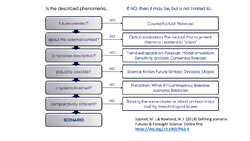Unsolved:Strategic foresight
Strategic foresight is a planning-oriented discipline related to futures studies, the study of the future. In a business context, a more action-oriented approach has become well known as corporate foresight.[1][2]
Definition and idea
Strategy is a high level plan to achieve one or more goals under conditions of uncertainty.[3] Strategic foresight happens when any planner uses scanned inputs, forecasts, alternative futures exploration, analysis and feedback to produce or alter plans and actions of the organization.[4][5] Scenario planning plays a prominent role in strategic foresight. The flowchart to the right provides a process for classifying a phenomenon as a scenario in the intuitive logics tradition and differentiates it from many other techniques and approaches to planning.[6]
Strategic planning always includes analysis, but it may or may not involve serious foresight on the way to developing a plan, or taking an action. A consideration of possible futures (alternative futures) and of probable futures (forecasts, predictions) is important to developing a preferred future (plan), even the simple mental plans made prior to taking an action.[7] It is the job of the strategic foresight professional to make sure appropriately diverse and relevant inputs, forecasts, and alternatives are considered in the analysis, decision making and planning processes, that plans are appropriately communicated and that when actions are taken, appropriate feedback occurs and after action reviews take place to improve the foresight process.[8]
Strategic foresight is a growing practice in corporate foresight in large companies.[9][1][2] Its use is also growing in government and non-profit organisations.[10][11] In recent years, researchers and managers have also elaborated more on the links between foresight and innovation management.[12]
Strategic foresight can be practiced at multiple levels, including:
- Personal – "Personal and professional goal-setting and action planning"[13]
- Organizational – "Carrying out tomorrows' business better"[14]
- Social – "Moving toward the next civilisation – the one that lies beyond the current hegemony of techno/industrial/capitalist interests"[15]
Quotes
- "Strategic foresight is the ability to create and maintain a high-quality, coherent and functional forward view, and to use the insights arising in useful organisational ways. For example to detect adverse conditions, guide policy, shape strategy, and to explore new markets, products and services. It represents a fusion of futures methods with those of strategic management" (Slaughter (1999), p. 287).[16]
See also
- Chain-linked model
- Corporate foresight
- Critical design
- Design fiction
- Forecasting
- Foresight (future studies)
- Futurology
- Optimism bias
- Reference class forecasting
- Science fiction prototyping
- Strategic Foresight Group
- Technology forecasting
- Technology scouting
References
- ↑ 1.0 1.1 Rohrbeck, Rene (2010) Corporate Foresight: Towards a Maturity Model for the Future Orientation of a Firm, Heidelberg: Physica-Verlag, Springer, ISBN:978-3-7908-2625-8
- ↑ 2.0 2.1 Rohrbeck, René; Mahdjour, Sarah; Knab, Sebastian; Frese, Tobias (2009-07-01). Benchmarking Report: Strategic Foresight in Multinational Companies. Rochester, NY. doi:10.2139/ssrn.1470050.
- ↑ Gerry., Johnson (2008). Exploring corporate strategy : text and cases. Scholes, Kevan., Whittington, Richard, 1958- (8th ed.). Harlow: FT Prentice Hall. ISBN 9780273711919. OCLC 316418838.
- ↑ Coates, Joseph; Durance, Philippe; Godet, Michel (2010). "Strategic Foresight Issue: Introduction". Technological Forecasting and Social Change 77 (9): 1423–1425. doi:10.1016/j.techfore.2010.08.001.
- ↑ Gavetti, Giovanni; Menon, Anoop (2016-09-01). "Evolution Cum Agency: Toward a Model of Strategic Foresight". Strategy Science 1 (3): 207–233. doi:10.1287/stsc.2016.0018. ISSN 2333-2050.
- ↑ Spaniol, Matthew J.; Rowland, Nicholas J. (2019). "Defining Scenario". Futures & Foresight Science 1: e3. doi:10.1002/ffo2.3.
- ↑ Amara, Roy (1974). "The futures field: Functions, forms, and critical issues". Futures 6 (4): 289–301. doi:10.1016/0016-3287(74)90072-x.
- ↑ Rohrbeck, René; Battistella, Cinzia; Huizingh, Eelko (2015). "Corporate foresight: An emerging field with a rich tradition". Technological Forecasting and Social Change 101: 1–9. doi:10.1016/j.techfore.2015.11.002. https://pure.au.dk/ws/files/91079561/Rohrbeck_et_al_2015_Corporate_Foresight_An_Emerging_Field_with_a_rich_Tradition.pdf.
- ↑ Oliver Schwarz, Jan (2008). "Assessing the future of futures studies in management". Futures 40 (3): 237–246. doi:10.1016/j.futures.2007.08.018.
- ↑ Heger, Tobias; Boman, Magnus (2015). "Networked foresight—The case of EIT ICT Labs". Technological Forecasting and Social Change 101: 147–164. doi:10.1016/j.techfore.2014.02.002.
- ↑ Harper, Jennifer Cassingena; Cuhls, Kerstin; Georghiou, Luke; Johnston, Ron (2008-05-01). "Future-oriented technology analysis as a driver of strategy and policy". Technology Analysis & Strategic Management 20 (3): 267–269. doi:10.1080/09537320801997193. ISSN 0953-7325.
- ↑ von der Gracht, Heiko; Vennemann, Robert; Darkow, Inga-Lena (2010). "Corporate foresight and innovation management: A portfolio-approach in evaluating organizational development". Futures - the Journal of Policy Planning and Futures Studies 42 (4): 380–393. doi:10.1016/j.futures.2009.11.023.
- ↑ Morrisey, George L. (1992), Creating Your Future: Personal Strategic Planning for Professionals, Berrett Koehler, San Francisco, CA.
- ↑ Hamel, G., & Prahalad, C.K. (1994), Competing for the Future, Harvard Business School Press, Boston MA.
- ↑ Slaughter, Richard A. (2004), Futures Beyond Dystopia: Creating Social Foresight, RoutledgeFarmer, London, UK. ISBN:978-0-415-30270-8; p. 217
- ↑ Richard, Slaughter (1999). Futures for the third millennium : enabling the forward view. St Leonards, N.S.W.: Prospect. ISBN 9781863161480. OCLC 43628902.
External links
- GLOGO – Global Governance System for strategic foresight at think tank Gold Mercury International
- Towards Critical Foresight
- Blog on corporate foresight and organizational future orientation
- How to make sense of your environment through strategic analysis
- Future Screening research project, a practical framework for advancing strategic corporate foresight
- Group in Xing: Strategic Foresight – Strategische Frühaufklärung
- The Importance of Strategic Alignment in the Execution Process
- The Master of Design in Strategic Foresight and Innovation program at OCAD University
- The Strategic Foresight and Innovation group on LinkedIn
- The Foresight, Education & Research Network "FERN" is a global community of foresight students, alumni, faculty, employers, and advocates of graduate foresight education, employment, and research.
- Global Foresight Org lists communities, degree programs, courses, people, employers, organizations, and educational materials that help advance our global foresight culture. It can be edited by anyone who wants to help.
- Association of Professional Futurists A global organization that advances strategic foresight through its credentialed members.
Scientific journals
- Technological Forecasting and Social Change
- Futures
- Futures & Foresight Science
- Foresight
- Journal of Futures Studies
- European Journal of Futures Research
Conferences


